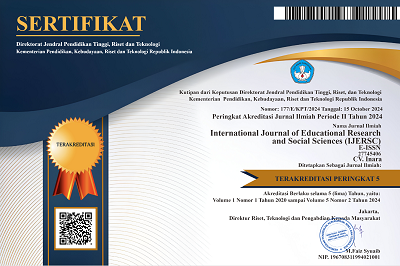Communication Strategy In Delivering Semester Credit System (SKS) Programs With Students At State Islamic Junior High School (Mtsn )Of 01 Medan City
DOI:
10.51601/ijersc.v2i6.196Published:
2021-12-19Downloads
Abstract
The aimed of this study was to determine the appropriate communication strategy in the delivery of the Semester Credit System program at MTsN 1 Medan. This is because there are still many students who do not understand the SKS program they are currently undergoing. The formulation of the problem in this study is how the strategy used in delivering the credit program at MTsN 1 Medan. The methodology used with a qualitative approach is by collecting data through in-depth interviews, observation, documentation, and conducting a literature review obtained from books, journals, seminar results and other scientific works relevant to the theme of communication strategy research. From the results of the study, it was found that there were communication strategies used, among others, by using redundancy, canalizing, informative, persuasive, educative, cursive methods, selecting communication media and using Dornyei taxonomy, namely the use of assistance. And as the results of this study, it can be concluded that the communication strategy in delivering the SKS program is effective as evidenced by a significant increase in students' understanding of the SKS program after the communication strategy is implemented.
References
Direktorat Jendral Penddikan Islam. 2019. Juknis Penyelenggaraan SKS di Madrasah Tsanawiyah. Jakarta: Kementrian Agama Republik Indonesia.
Al, Jamal Dina. 2016. Communication Strategies for Teacher and Their Students in an EFL Setting. International Journal of Bilingual & Multilingual Teachers of English. DOI: 10.12785/ijbmte/040105 diakses pada 2 Oktober 2021
Asep, Sudarman. 2018. Strategi Komunikasi untuk Meningkatkan Kesadaran Masyarakat dalam Membayar Zakat Maal. Communicatus: Jurnal Ilmu Komunikasi Volume 2 Nomor 1 39-60.
Asgarwijaya, Dwiyan. 2015. Strategi Komunikasi Interpersonal antara Guru dan Murid Paud (Studi Deskriptif Komunikasi Interpersonal Antara Guru dan Murid PAUD Tunas Bahari Dalam Kegiatan Belajar Mengajar. E-Proceeding of Management: Vol.2, No.1 April 2015 | Page 1008, 2355-9357. Diakses pada 4 Sepetember 2021
Effendy, Onong Uchjana. 2003. Ilmu, teori dan filsafat komunikasi. Bandung : Citra Aditya Bakti
Ekeowa, Lovlyn Kelvin-Iloafu. 2016. The Role of Effective Communication in Strategic Management of Organizations. International Journal of Humanities and Social Science Vol. 6, (No. 12. 2220-8488 , 2221-0989)
Junita, Ike Triwardhani. 2020. Strategi Guru dalam membangun komunikasi dengan Orang Tua Siswa di Sekolah. Jurnal Kajian Komunikasi, Volume 8, No.1 2303-2006, 2477-5606.
Macnamara, Jim. 2021. A Macro View of Strategic Communication Management: Beyond ‘siloes, dominant paradigms, and pandemics. Essachess Journal for Communication Studies Volume 14 Issue 1(27), (p.65-91)
Maleki, Atollah. 2010. Techniques to Teach Communication Strategies. Journal of Language Teaching and Research, Vol. 1, No. 5, (pp.640-646, 1798-4769).
Miles, M.B. & Huberman, A.M. 1984. Qualitative Data Analysis: A Sourcebook of a New Methods. Baverly Hills, California: Sage Publications, Inc
Mutia, Nurul Utami. 2018. Communication strategies used by junior and senior teachers in teaching English at secondary school. International Journal of Humanities and Innovation (IJHI) Vol. 1 No. 4. (pp. 218-227)
Saputro, Budiyono. 2016. Manajemen Penelitian Pengembangan. Yogyakarta : Aswaja Pressindo
Sugiyono. 2018. Metode Penelitian Kuantitatif, Kualitatif dan R dan D. Bandung : Alfabeta
Tarone, E. 1980. Communication Strategies, Foreigner Talks, and Repair in Interlanguage. Language Learning, (30, 417 – 431).
Rastegar, Mina & Samira Sadat Mirzadi Gohari. 2016. Communication Strategies, Attitude, and Oral Output of EFL Learners: A Study of Relations. Open Journal of Modern Linguistics, (401-419, 2164-2834, 2164-2818)
Rosmania, Rima, M.Hum. 2016. Strategi komunikasi dalam diskusi kelompok sebuah kajian pada mahasiswa jurusan pendidikan bahasa inggris. Jurnal Makna, Volume 1, Nomor
Panggabean, I.T., Christina & Agus Wardhono. 2017. Communication Strategies Used by EFL Students in Their Presentation. Indonesian EFL. Journal of ELT, Linguistics, and Literature. (2460-0938, 2460-2604).
Putu, Ni Era Marsakawati. 2012. Strategi Komunikasi: Sebuah Solusi. Lingua Didaktika Volume 6 No 1
Trianto, Rudi. Perencanaan Strategi Komunikasi Pemasaran Sekolah Islam di Surabaya (Study Kasus di Sekolah Dasar Integral Luqman Al Hakim (SDILH) Surabaya). Jurnal Prodi Komunikasi Penyiaran Islam An-Nida. 2354-6328 ,2598-4012.
Wahyu, Heny Tamara Dwi Lestari, Dindin Dimyati & Mohammad Shihab. 2017. Strategic Communications and Corporate Branding. A Study of Jebsen & Jessen Indonesia Group. Media Tor Vol 10 (1) (37-52).
Wahyu, Ika Pratiwi. 2020. Strategi Komunikasi Interpersonal Guru dalam Pembelajaran Jarak Jauh di Sekolah Dasar, Klaten Jawa Tengah. JP3SDM, Vol. 9. No. 2
Yusparizal. 2018. Communication Strategies Used by ELT Students Across Genders. Jurnal Pendidikan Humaniora. Volume 6, Number 1, March 2018, ( pp. 24–47 2338-8110, 2442-3890).
Yuni, Asih Trihastuti & Zamzani. 2018. The Role of Communication Strategies in the Classroom Communication. Advances in Social Science, Education and Humanities Research, volume 165 2nd International Conference of Communication Science Research ICCSR.
License
Copyright (c) 2021 International Journal of Educational Research & Social Sciences

This work is licensed under a Creative Commons Attribution 4.0 International License.






